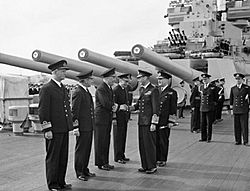Louis Keppel Hamilton facts for kids
Quick facts for kids
Sir Louis Keppel Hamilton
|
|
|---|---|

Rear Admiral Keppel Hamilton, second from left, meets King George VI aboard HMS Duke of York at Scapa Flow, August 1943
|
|
| Born | 31 December 1890 St George Hanover Square, London |
| Died | 27 June 1957 (aged 66) King Edward VII's Hospital, London |
| Allegiance | United Kingdom |
| Service/ |
Royal Navy |
| Years of service | 1908–1948 |
| Rank | Admiral |
| Commands held | Chief of the Australian Naval Staff (1945–1948) Flag Officer, Malta (1943–45) 1st Cruiser Squadron (1942–43) Home Fleet Destroyer Flotillas (1941) HMS Aurora (1940) HMS Ambuscade (1928–29) HMS Wild Swan (1927–28) HMS Wanderer (1927) HMS Taurus (1917–18) HMS Moorsom (1915–16) |
| Battles/wars | First World War
|
| Awards | Knight Commander of the Order of the Bath Distinguished Service Order & Bar Mentioned in Despatches (2) Order of Saint Stanislaus, 3rd Class (Russia) War Cross (Norway) |
Sir Louis Henry Keppel Hamilton (born December 31, 1890 – died June 27, 1957) was a very important officer in the Royal Navy. He served as a Flag Officer in Malta from 1943 to 1945. Later, he became the head of the Royal Australian Navy. During his early career, people often knew him as L. H. Keppel Hamilton.
Contents
Admiral Hamilton's Early Life
Louis Hamilton was the first of two sons. His father, Sir Frederick Hamilton, was also a high-ranking naval officer. His mother was Maria Walpole Keppel. She was the daughter of another famous admiral, Sir Henry Keppel.
Louis grew up in a place called Anmer Hall in Norfolk, England. Many of his family members, including his grandfathers, were also in the Royal Navy. This meant he came from a long line of naval heroes.
Louis Hamilton joined the Royal Navy in 1908. He started as a midshipman, which is a junior officer rank. He quickly moved up the ranks. By 1911, he was a sub-lieutenant, and in 1913, he became a lieutenant.
Serving in World War I
During the First World War, Hamilton saw a lot of action. He fought in the West Africa Campaign. This included battles on the Niger River and in the German colony of Kamerun.
In December 1914, he led a group that pushed German forces out of Dehane. He also led an amazing journey. His team moved a large naval gun 640 miles along rivers. Then they carried it 60 miles over land. This gun helped British forces capture Garoua in June 1915. For his bravery, he received the Distinguished Service Order. He also got an award from Russia.
World War II Heroics
Hamilton served again during the Second World War. In 1940, he commanded HMS Aurora. He took part in the Allied response to Germany's invasion of Norway. For this, he received the Norwegian War Cross.
He also helped protect Arctic convoys. These were groups of supply ships sailing through dangerous waters. In 1942, he was a Rear Admiral. He commanded the First Cruiser Squadron. This group included both British and American warships.
From 1943 to 1945, Hamilton was the top naval officer in Malta. While there, he was knighted, becoming "Sir Louis Hamilton."
After the war, he moved to Australia. From 1945 to 1948, he was the professional head of the Royal Australian Navy. He was promoted to Admiral in 1947. He retired from the navy in September 1948.
Sir Louis Hamilton passed away on June 27, 1957, in London.

